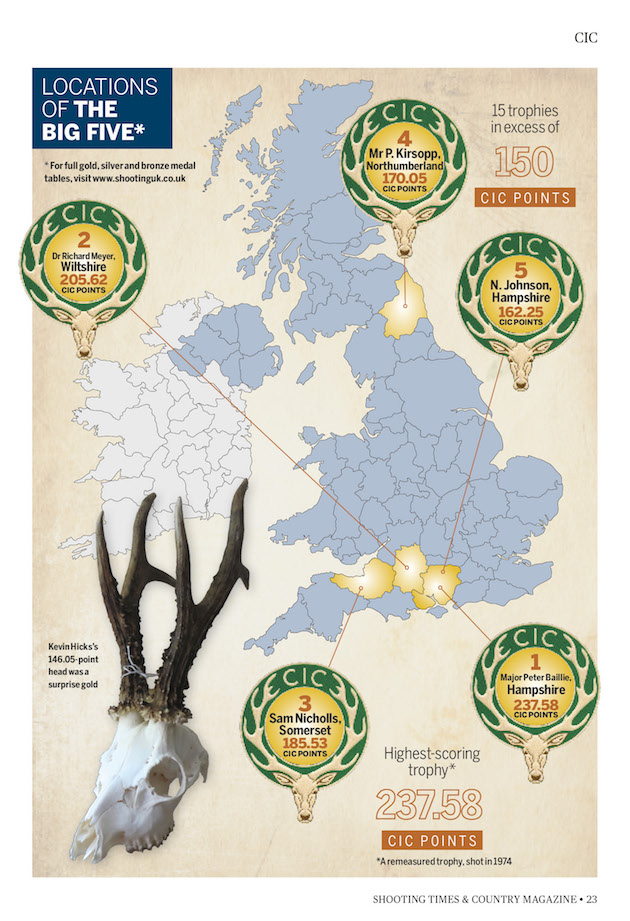English and Welsh Roe Review 2018
Tony Dalby-Welsh looks back over a record year, in which the usual counties dominated and more trophies reached medal standard
English roe had a good year in 2018. After reporting an increased number of heads presented for measuring in 2017 — the best on record — we were prepared for a slower year in 2018. Reports from stalkers across the country were suggesting lower numbers of quality bucks.

As so often happens, a result perhaps of the increased feed available in winter and despite the Beast from the East taking some lesser specimens, this was not to the case.
Numbers presented for assessment rose to a new high of 1,710 heads, 387 of which were English roe — 400 were Scottish roe — and 308 reached medal standard, an increase of 28 per cent. Of these, 64 were of gold medal quality, another increase on last year, this time by 22 per cent.
That said, in terms of individual UK quality, with the number of heads exceeding last year’s tally, the quality was slightly down. Fewer heads scored more than 160 CIC points. The huge ones of the past were not so noticeable.
Members of the CIC team enjoyed the opportunity to remeasure — or at least attempted to remeasure — Major Peter Baillie’s famed monster, shot in Hampshire in 1974. The very speediest of readings were required in gauging the volume of this porous head, as were lengthy waits between repeated attempts.
We arrived at a consensus in preparation for the head being shown at the World Hunting and Nature Expo in Budapest in 2021, despite an inevitable rider on accuracy. It was interesting to scrutinise the first measurements taken and note the differences since.
Longest antlers
Dr Richard Meyer’s Wiltshire roe was the other outstanding head measured in 2018. Despite having some mystery about it — and it having reportedly been subject to some form of ad hoc assessment — this was its first official measurement. It scored a healthy 205.62 CIC points and its average beam length of 30.65cm put it into the top four longest roe antlers recorded. It too will go to the Budapest expo.
Three counties continue to stand out in terms of the quality of heads. Hampshire led the field with 49 heads, of which 15 were gold medals. Wiltshire followed with 47 heads, though only four made gold. Somerset produced 43 heads with nine golds. These were followed by Oxfordshire, 27 heads and seven golds; Dorset with 20 heads but only three golds; and Gloucestershire with 14 and three golds.
Other consistent producers of medal heads, albeit in smaller numbers, are Northumberland with four golds from 13 heads, Cumbria with nine heads and Worcestershire with four heads, two of which were healthy golds.
Mr P. Kirsopp’s Northumberland head measured 170.05 CIC points, the highest-scoring head from that county to date. Dr Richard Meyer had another Somerset head at 153.28 points and others of note include Sam Nicholls’s 185.53 head, again from Somerset.
Stalkers are often surprised by the results of their activities and ever more pleasantly surprised when the result is a gold medal. Kevin Hicks’s 146.05-point head is a good example, as is Declan Mouland’s slightly smaller head at 131.45.
Wide heads don’t always score well, but Aaron Holmes’s 152.78 head from Dorset proved an exception to the rule, as did Mike Bagnowiec’s very narrow head from Gloucestershire, which scored 135.67.
When a hunter produces the fruits of his labours from a period of years it is always gratifying to see the care with which they manage their deer populations. One of these was a Belgian hunter whose careful management of an estate in southern England has brought increased quality over the year. There was a range of medals from gold, at just over the threshold at 131.53 CIC points, down to a bronze at 105.2 CIC points. It’s not always only about size.
Scottish Roe Review 2018 – the CIC tables
More than half a century ago, when Shooting Times started publishing annual reviews, if you stalked a roe north or…
Scottish roe review 2017
With a score of 175.93, K. Mehl’s Aberdeenshire trophy took top honours for Scotland in 2017, maintaining that county’s place…
English and Welsh roe review 2017 and other species
The CIC’s trophy measuring system has had another good year. Newly qualified UK measurers got into their stride throughout 2017…
Other figures
Farewell Charles
One of the UK CIC’s senior measurers, Charles Fenn, died suddenly in late October 2018. Having been a measurer for more than 20 years, Charles had become very much an expert on sika, his preferred species. Having also developed an expertise with African species, he was appointed a senior international trophy judge in 2016, contributing to the work of the International Trophy Evaluation Board (TEB) and representing the UK TEB in that forum.
Those who knew Charles always speak of his readiness to help stalkers, to explain the somewhat esoteric ways of the measuring system and to encourage hunters to look after their quarry in the spirit that the CIC has always embodied. He will be sorely missed.












